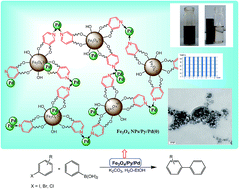Palladium stabilized by 3,4-dihydroxypyridine-functionalized magnetic Fe3O4 nanoparticles as a reusable and efficient heterogeneous catalyst for Suzuki reactions
Abstract
A Pd supported on 3,4-dihydroxypyridine (Py)-functionalized Fe3O4 (Fe3O4/Py/Pd) hybrid material has been synthesized for the first time. Inductively coupled plasma (ICP), energy dispersive X-ray spectroscopy (EDX), transmission electron microscopy (TEM), scanning electron microscopy (SEM), and field emission scanning electron microscopy (FESEM) and Fourier transform infrared (FTIR) studies have been used to characterize the catalyst. The catalyst exhibited very high activity for Suzuki coupling reaction of several aryl halides with phenylboronic acids in aqueous phase at room temperature. The most interesting result of this work is the possibility to perform Suzuki reactions of aryl chlorides in the presence of the prepared catalyst. The yields of the products were in the range from 70% to 98%. In this process, the novel catalyst could be recovered in a facile manner from the reaction mixture by applying an external magnet device, and reused more than eight times without any significant loss in activity.


 Please wait while we load your content...
Please wait while we load your content...